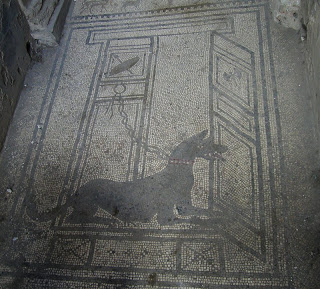 |
| The famous "Cave Canem" mosaic at the entrance of the House of the Tragic Poet, Pompeii |
It struck me that the entrance’s floor was sloping. So, I thought, not only the artefact is exhibited (in the Museum of Naples) on a wall when it was supposed to be on the floor, but it is also exhibited perfectly flat when it was meant to be inclined. It looked like a potentially straightforward and effective case for a 3D contextualisation.
I started investigating what you could see from the entrance, how the dog mosaic interacted visually with the other elements in the house: the impluvium, the water and its reflection, the opening on the garden at the back of the tablinum, the actual plants and the painted landscape, the columns, etc... Very exciting (to me, at least!). My attention was also drawn on the interaction between the mosaic and the entrance doors and on the possible shape and movement of doors working on a sloping floor. Even more exciting.
Then, The-Winged-Genius-of-Best-Practice seated on my shoulder and whispered in my ear: “did you check the original records? I mean, are you 100% sure that the mosaic was found at the entrance?”
“Of course I’m sure!” I told the winged creature “where else would you put such a mosaic? Have you ever been in Pompeii?! They are ALL at the entrance!”
“Of course I’m sure!” I told the winged creature “where else would you put such a mosaic? Have you ever been in Pompeii?! They are ALL at the entrance!”
 |
| Mosaic of a Chained Dog, Entrance of the House of Paquius Proculus, Pompeii |
According to Matteo della Corte’s records, the mosaic wasn’t found at the entrance but in room 9, a little, beautiful, extremely decorated room just at the right of the entrance (the space that is often occupied by the porter guard).
The mosaic was actually flat, there was no relevant visual interaction with the garden, the impluvium or any other architectonical feature. Actually, the mosaic is not even visible from the street.
I was misled by my experience of the site and by own cultural background according to which such signals (proper or whimsical) are always put in a place where everybody can see them BEFORE entering or approaching a house. So much so that, according to what I have read, a house owner might have even found a “beware of the dog” mosaic more affordable (and almost equally effective) than an actual dog.
Being the function of such artefacts usually to warn and scare visitors (or potential offenders), it was quite sensible to assume that they were placed in the point of the house that is most visible from the street. Nonetheless, I shouldn’t have assumed it.
The fact that the other mosaics with dogs survived in Pompeii are at the entrance doesn’t mean that they ALL used to be placed at the entrance.
 |
| Mosaic of a Sleeping Dog, Entrance of the House of Caecilius Iucundus, Pompeii |
So, what was I supposed to do? It was too late to choose another case study. I had to sort out something with what I had got: a small mosaic of unknown function found in a room of unknown function. I know, it doesn’t sound great...
Actually, the more I tried to understand this artefact and its context, the more it won my interest and attention. In the end I was completely absorbed by this little pseudo-mystery. So I told myself: “it wouldn’t be perfect if I could make the audience as engaged as I am with the understanding of this artefact?”.
And that became my new plan...
No comments:
Post a Comment